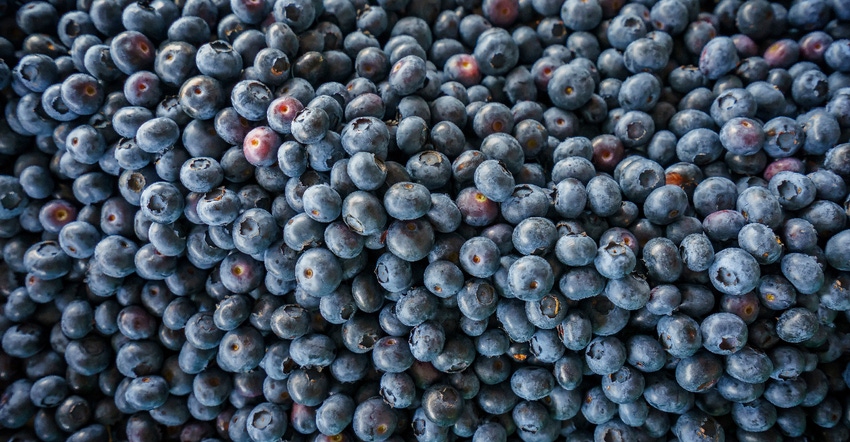
For Rex Schultz, the retirement he’d planned from his full-time management job at True Blue Farms will likely be pushed back. He had hoped to concentrate solely on his 60 acres of blueberries on his Heritage Blueberry Farm in Bangor, Mich.
“But the profits are not there anymore,” he explains. Massive imports from mainly Canada, Mexico and Peru have diluted the market. “In the last five years, we've lost over 30% of our pricing, combined with a 15% to 20% increase in inputs; we’re talking a hit of basically 45 to 50%,” Schultz adds.
Before the blueberry industry implodes, blueberry growers across America are fighting back by establishing a new coalition — American Blueberry Growers Alliance — to seek relief from rising imports threatening their livelihoods.
The alliance, funded by dues paid by growers and grower organizations, will provide information and support to an ongoing U.S. International Trade Commission investigation into the serious injury caused by increased imports of fresh, chilled and frozen blueberries under Section 201 of the Trade Act of 1974. The president will take action if the ITC finds that increased imports are causing serious injury to the U.S. blueberry industry.
Blueberry imports are sourced from several countries in the Western Hemisphere. Imports rose by more than 60% between 2015 and 2019. Imports from Peru and Mexico have increased by 1,258% and 268%, respectively, during that same period, driving blueberry prices down by double digits.
Schultz, who also serves as president of the Michigan Blueberry Advisory Committee, says the ITC needs to get involved because the imports are not going away. In fact, they are continuing to ramp up.
Late-harvest price spike
Growers mainly in the Pacific Northwest and Michigan used to capitalize on their late-season varieties drawing a premium as the U.S. growing season drew down.
“Peru used to send blueberries into the U.S. and Michigan in November, but now they're wanting in on that little spike in prices and are backing up and coming in as early as September and even late August — during our marketing window,” says Schultz, who started blueberry farming with his father-in-law in the 1990s. In 2004, he picked up 35 acres of his own and expanded that to 60 acres in 2015.
Michigan, which produces about 20,600 acres of blueberries and about 100 million pounds of blueberries annually, harvests at the end of July and early in August, but the strong pricing is in the late season.
“We need that late season in Michigan to recover from the losses we sustained during the midseason,” Schultz says. “And what's most disturbing, none of Peru’s blueberry production is for its own consumption. If you look at the reports in Peru, it exports 100% of its blueberries, with the majority — over two-thirds — coming into the U.S.”
U.S. growers have documented the damage and are asking for an evaluation to determine if there is injury to domestic growers, which could allow for remedies such as tariffs or other restrictions.
Canada and Peru imports affect the Michigan market the most, Schultz says. Florida, Georgia and California are pressured by Mexican imports.
Distorted markets
These foreign producers have substantially increased capacity, often with government infrastructure assistance.
Speaking for Michigan and not the American Blueberry Growers Alliance, Schultz says it desperately needs a level playing field. “Their labor is a lot cheaper than ours, and according to a 2018 U.S. Department of Labor study, 62% of the ag workforce in Peru is child labor,” he says.
While the situation is being investigated, Schultz is supporting the American Grown campaign, in hopes that consumers will read more labels and recognize blueberries grown in the U.S. as a premium product.
“Only 1% of blueberry imports are inspected,” he says. “These countries growing fruits and vegetables, we don't know what they're putting on them. We do know the tiny amount being inspected has five times the rejection rate of U.S. product.
"Knowing 99% of that product is coming into this country uninspected, are you willing to roll the dice on what chemicals are being used? The rejections tell us they are far exceeding the limits set by the USDA.”
Even if the ITC rules in favor of U.S. growers, Schultz says, “We have to be more creative, innovative, and we have to try to plant some new varieties that can give us some higher yields."
Blueberries boost economies
Blueberry bushes can pop up all over the U.S., and while 38 states grow blueberries commercially, 10 states account for more than 98% of U.S. commercial production: California, Florida, Georgia, Indiana, Michigan, Mississippi, New Jersey, North Carolina, Oregon and Washington, according to the U.S. Highbush Blueberry Council.
In 2019, New Jersey blueberry growers harvested 46 million utilized pounds from 9,300 acres, according to USDA. The value of utilized production was more than $85 million.
Michigan’s value of utilized production was $75,258, even though it had more than double the acreage of New Jersey.
While the state’s checkoff program doesn’t get involved in any federal proceedings or investigations, Kevin Robson, executive director of the Michigan Blueberry Commission, says, “Michigan is home to the finest blueberry farmers in the world. When it comes to quality fruit at a fair price, I believe our growers do it best. However, with the economy transitioning to be more global in scope, we struggle against other countries that aren’t playing by the same rules.
"When it comes to food safety regulations, crop protection procedures and regulations, along with worker protection standards and adverse-affect wage rating schedules, we do more than any other country when it comes to protecting our labor force and ensuring the safety of our fruit. There’s no doubt our cost of production is higher. If it were a more levelized playing field, no country could rival our blueberry growers.”
About the Author(s)
You May Also Like






